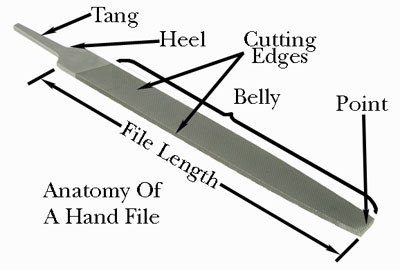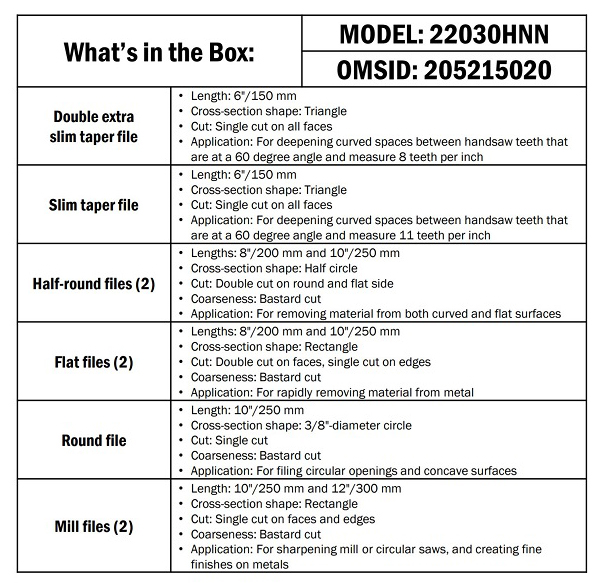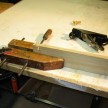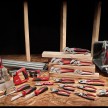Nicholson Hand Files
Nicholson 9 Piece Hand File Set with Ergonomic Handles, American Pattern
By Ralph Mroz
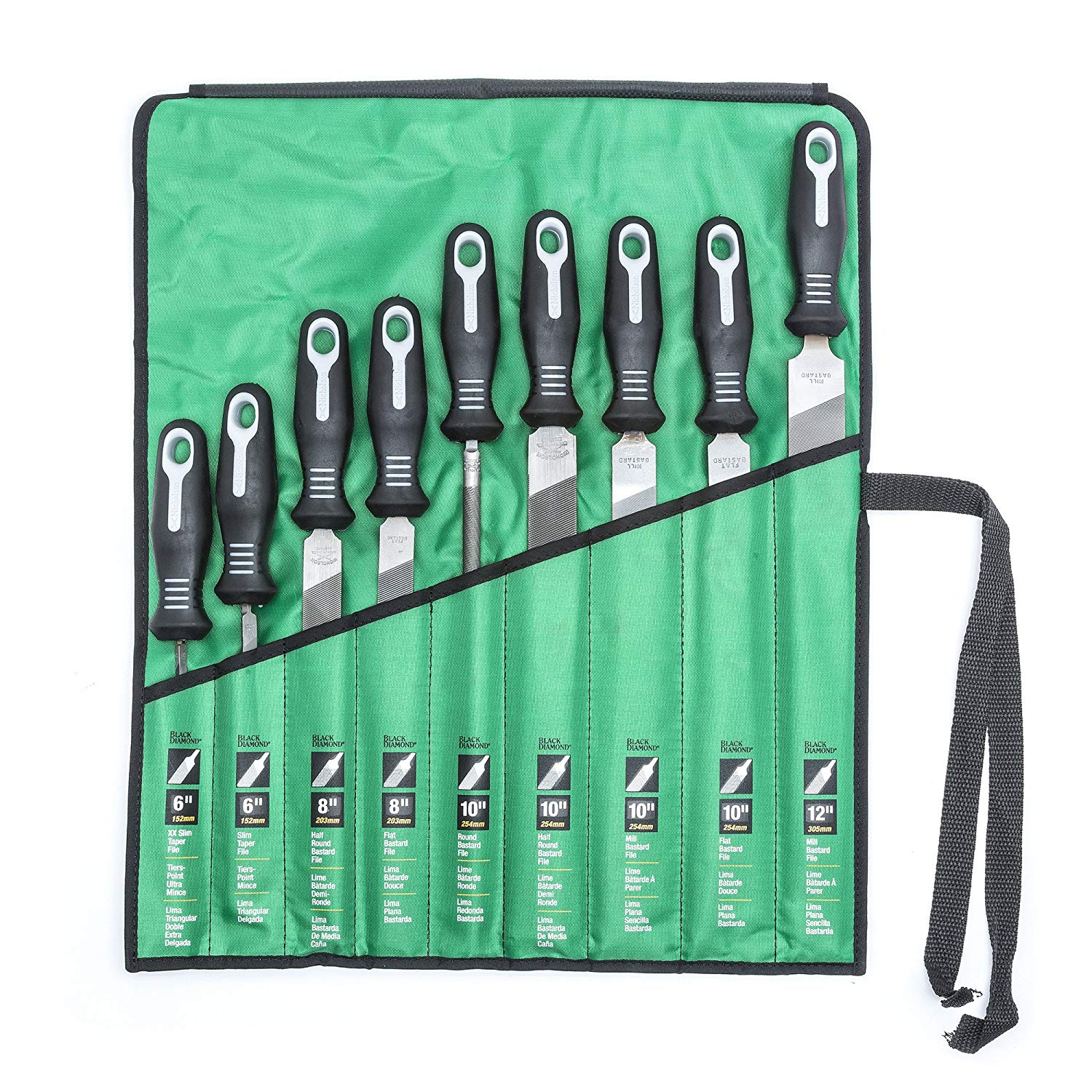 Everyone uses files, this article is about Nicholson Hand Files. Plumbers, carpenters, electricians, HVAC technicians, fabricators, mechanics, machinists, auto body technicians. Woodworkers and cabinet and furniture makers use them too, only they’re called rasps.
Everyone uses files, this article is about Nicholson Hand Files. Plumbers, carpenters, electricians, HVAC technicians, fabricators, mechanics, machinists, auto body technicians. Woodworkers and cabinet and furniture makers use them too, only they’re called rasps.
Everyday files come in a mind-boggling variety of types, shapes, sizes, and coarseness levels. Add in the special files made for specific trades or applications, and for materials other than wood or steel, and it’s way too much to keep track of.
Because the trades are the focus of this site, here we’ll give a very brief overview of the types of files that a trades person might use in the normal course of their job and the terms that describe them, and we’ll focus just on files for abrading metal (rasps have their own peculiar terminology and nomenclature).
File Families
There are two main families of files are American Pattern and Swiss Pattern. In the states we’re much more likely to see American Pattern files, which are usually between four- and 16-inches long, and graded into three common, and six total, levels of coarseness.
Swiss Pattern files are smaller — usually between three- and 12-inches long. They come in seven levels of coarseness, and are used typically for finer and more precise work than American Pattern files. You don’t see them used for general-purpose work in construction much. We’re only talking about American Pattern files below.
Teeth Direction(s)
The term “cut” used in reference to files can mean two things. One meaning refers to the number of directions in which teeth are cut on a file. A single-cut file has a single set of parallel, diagonal rows of teeth. Single-cut files are often used with light pressure to produce a smooth finish. A double-cut file has two sets of diagonal rows of teeth. The second set of teeth is cut in the opposite diagonal direction to the first. A double-cut file is usually used with heavier pressure than a single-cut and removes material faster from the workpiece. Some files are single cut on one side and double cut on the other.
There are other, often proprietary, geometries of teeth patterns on files, but the single- and double-cut are the basic ones.
Coarseness Levels
“Cut” can also refer to the coarseness of the file teeth. American Pattern files come in common coarseness grades, or “cuts”, of (from most to least coarse): coarse, bastard, second-cut, and smooth.
From there it gets a little complicated. You cannot know how coarse a file is by its grade of cut alone — you have to also know its length. That’s because the cut of a file refers to the number of lines of teeth it has along its length, and for each cut for each manufacturer, that is a constant number regardless of length. For example, a six-inch bastard cut file will have the same number of lines of teeth as a 16-inch bastard file, which obviously means that the 16-inch bastard file will be coarser and more abrasive than the six-inch bastard file. Likewise, a six-inch second-cut cut file will have the same number of lines of teeth as a 16-inch second-cut file, and so on.
In other words, a six-inch bastard file will have more teeth per inch, than a 12-inch bastard file.
Further complicating matters: each manufacturer has their own specification regarding how many teeth per file constitutes each “cut” grade of coarseness. This difference is usually only 2-4 teeth per inch between manufacturers, but it does mean that each manufacturer’s file of the same length and cut will vary slightly in coarseness.
To make is even more complicated, different types of files (see just below) will have somewhat different specs for each coarseness “cut”, even for the same length. For example, a 10-inch bastard flat file will have coarser teeth than a 10-inch bastard mill file.
And if you want to get really geeky, the geometry of the teeth and valleys can vary by application and manufacturer…but that’s way beyond us here.
American Pattern File Types
What follows are definitions of the three most common American Pattern files types that a contractor might use, as these terms are usually employed. Note that not all manufacturers conform to all of these definitions.
Flat file
While most rectangular- or square-cross sectional files are flat, the term “flat file” specifically refers to a rectangular cross sectional file whose width (and possibly thickness) tapers towards the point. Flat files are double cut on the faces and single cut on the edges
Hand file
While all files used by hand are generically hand files, the term “hand file” refers to a rectangular cross sectional file whose width does not taper towards the point. Hand files usually have one smooth face, so that edge can be run up against a surface without marring it.
Mill files
A mill file is a flat file with a single cut (one diagonal direction of teeth) on both sides. These are usually used for finer work such as sharpening saws and other delicate cutting blades.
Handy files, etc.
Flat files with integral handles instead of tangs are called, depending on their other characteristics: axe files, farmer files, handy files, and other names. These are quick-and-dirty general purpose files, usually meant for field use.
Triangular taper files
only have one type of coarseness. They are mainly used for saw sharpening and not for material removal.
Of course files can also have round, half-round, square, or any number of other cross sectional shapes, in any length, and these files can have their own nomenclature, as do rasps.
Don’t Worry About It
So yes, it’s very complicated and you aren’t going to remember all of these specs and differences. What most of us do is simply have a good collection of files in various lengths, shapes, and coarseness levels. We pick the one that seems right for the job without worrying about exactly how it might be specified.
File Maintenance and Life
Maintaining files is pretty easy. Don’t store them naked someplace where they can clang and clatter together. Brush them out with a proper file card (file brush) during and after use. Don’t let them rust. Common sense. You can also keep coated your files coated with oil or rust preventative during storage to prevent rust.
With respect to how long a file lasts, we have to realize that files are consumable items just like any other abrasive. They don’t wear out as quickly as sandpaper, yet they probably have fewer full-on work hours in them than a good quality saw blade. Tradies that use them all day every day will go through them pretty quickly. If you use files a lot, you’ll simply be replacing them periodically.
Nicholson 9 Piece Hand File Set with Ergonomic Handles, American Pattern
If you’re looking for a great set of files that will meet virtually all of your needs on a jobsite, and comes at a reasonable price, the Nicholson 9 Piece Hand File Set with Ergonomic Handles, American Pattern (part number 22030HNN) is your huckleberry.
Nicholson Hand Files:
- 6″ xx slim taper file
- 6″ slim taper file
- 8″ flat bastard file
- 8″ half-round bastard file
- 10″ half-round bastard file
- 10″ flat bastard file
- 10″ round bastard file
- 10″ mill bastard file
- 12″ mill bastard file
- Roll-up pouch
The grips (handles) on each file are co-molded with a hard inner structure for strength and a softer outer layer for comfort. I’ve used a lot of uncomfortable file grips over the decades, and these are a very pleasant surprise — they really are comfortable and ergonomic. The flared handle neck coupled with its grippy material prevents slipping quite effectively. It’s hard to imagine a jobsite task — or even a shop task — that one of these files isn’t the right tool for.
Making Metal Shavings
I tried out a variety of the Nicholson Hand Files on each of aluminum, brass, and several steels: 12L14, 4140, W-1, 1018, and 52100 bearing steel. Each file bit into each material well, with the softer steels and metals naturally abrading away faster. After using files that had pretty much outlived their work lives for the last few years, it was a joy to be again using proper tools that performed well. On each metal, each file did just what you’d expect that file to do on that particular material. The handles made handling and applying pressure to these files easy.
On a jobsite (as opposed to the shop) I’m most likely to be using hand files for knocking sharp edges off of protruding bolts, angle iron, conduit, or any other metal pieces (garage door rails, for example). Oddball tasks like having to enlarge a hole that butts up against metal (maybe a joist hanger), or alter the shape of a light fixture opening, are always arising on the job. These tasks come up regularly and consistently on any jobsite. For these times, a good selection of good hand files is essential. The Nicholson 9 Piece Hand File Set with Ergonomic Handles, American Pattern fits the bill perfectly. When trying out this file set I made an extra effort to make sure I knocked down and de-burred all the edges of every piece of metal I was working with or on. Each file did the job well, with nothing to be desired. I can’t tell you how nice it is to have a proper set of files to reach for!
I really appreciated the fact that I was using a file set, and one that came in its own pouch. Each pouch pocket clearly states what kind of file it contains, and its cut. This took much of the guesswork out of selecting the right file for the job, and the pouch was light-years better than fishing through a pile of files in a box. Upgrading to this Nicholson file set solves one of the little problems that’s been vexing me for years: not knowing if I’d grabbed the right file for the job, and being disappointed with an old file’s performance. Using the right tool makes everything easier!



